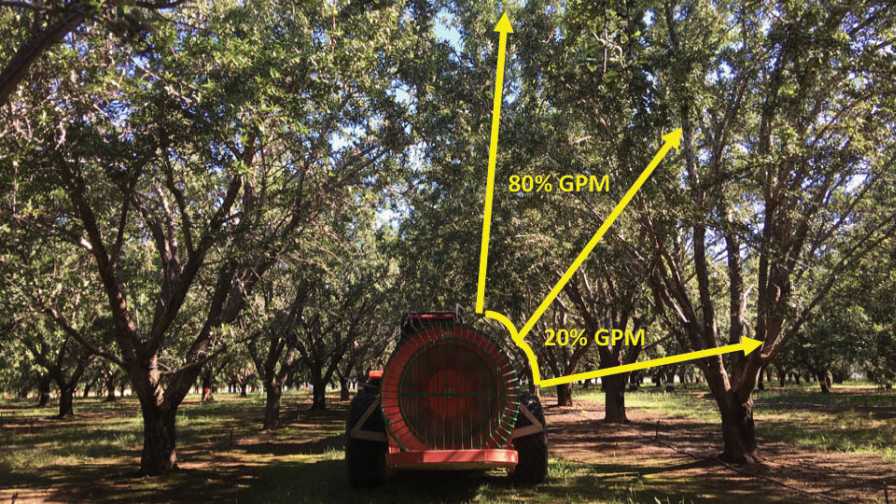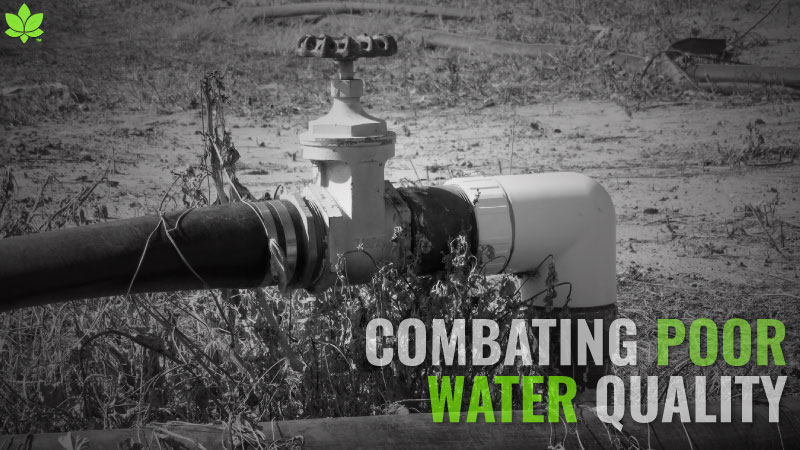Improve Spray Coverage for Better Almond Pest Control

This graphic illustrates how growers can improve spray coverage when most of the volume is directed at the upper canopy where the greatest leaf area and amount of crop is found.
Illustration by Franz Niederholzer
With populations of almond pests such as navel orangeworm (NOW) and spider mites on the rise, achieving complete spray coverage is crucial for effective management. NOW can cause direct damage to nut meat and leave the almonds more susceptible to fungal infections and harmful aflatoxins. High spider mite population can cause leaf damage and subsequent leaf drop. Severe leaf loss in one year could potentially mean reduced tree growth and crop yield in the next year.
NOW is best treated with a management plan that includes both sanitation and chemical sprays, while management of spider mites benefits from a mix of conservation biological control and control sprays. Efficiently applying sprays for these pests can save you money, labor, and time.
Don’t Forget to Sanitize
Chemical management of NOW is best done at hull split, when the females are actively laying eggs in the sutures. If an orchard has a history of high NOW populations, a May spray also may be effective. However, it is important to use a chemical other than pyrethroid for a May spray as pyrethroids may wipe out the spider mites’ natural predators, six-spotted thrips.
Besides making spider mite control more difficult, using pyrethroids more frequently may have diminishing returns as resistance is possible. Sprays are not recommended during the dormant season or bloom. At these times, sprays targeting specific life cycles of the NOW will not be effective and could harm pollinators. While sprays are a fundamental part of pest management, spraying for NOW is more effective if paired with sanitation.
“No amount of sprays is going to reduce the navel orangeworm populations like sanitation,” Dr. Emily Symmes, University of California Area Integrated Pest Management Advisor for the Sacramento Valley Region, stresses. “Growers will get more bang for their buck if spraying regimens accompany sanitation efforts.”
Since NOW can overwinter from one year to another in mummies, Symmes suggests growers shake the mummies in the late fall and winter and mow or grind the nuts. While this sanitation can accrue labor costs, it is effective at reducing the population, which can save on labor and the cost of sprays the following year.
Don’t Forget Spray Coverage
Chemically managing NOW control requires making contact with the larva, and it’s necessary to completely cover the canopy with the spray. Coverage is largely dependent on spray volume, nozzles, and canopy size. One acre of a mature almond orchard has roughly 6 to 8 acres of leaf surface, and reaching all the leaves requires a high spray volume. In the past, 100 gallons/acre was recommended, but the recommendation has now increased to 150 to 200 gallons/acre. To reach the entire canopy, growers need to calibrate their sprayers for efficient air flow and spray flow.
Spraying the canopy means replacing the resident air present with spray-filled air. This isn’t achieved by increasing the volume but by reducing your land speed. The best land speed is two miles per hour, or a similarly slow speed. To get the best spray flow target the upper half of the canopy with two-thirds of the spray. This way, the spray will reach most almonds. It’s important to play with these factors prior to hull split.
Dr. Franz Niederholzer, a University of California Cooperative Extension Orchard Systems Advisor in Colusa, Sutter, and Yuba counties, outlines a plan to help growers determine their spray coverage and make necessary adjustments to their spray flow and air flow. You can attach water-sensitive paper to PVC poles or tie the papers to the tops of trees throughout the orchard, as spray coverage is toughest in the upper canopy.
After filling the spray tanks with clean water, run the sprayer through the orchard at or around 2 mph and direct the spray to the upper part of the canopy. After running through the orchard with the sprayer, you can visually observe spray coverage on water-sensitive paper, then adjust your spray volume, nozzles, and direction to zero in on effective coverage.
Field research by Dr. Joel Siegel (USDA-ARS) and Matt Strmiska (Adaptiv) showed that excellent coverage — 50% of the water-sensitive paper covered — delivers the best NOW control, though you must decide what works best for your situation. When the sprayer is calibrated, it is best to spray for control when temperatures decline and humidity increases, such as during the night. While the sprayer testing and calibration can be a full day of work and making time in an already busy schedule is challenging, Niederholzer encourages growers to pay close attention to the basics of spraying.
“Chemical control is the last, critical step in an integrative pest management system, and if all the factors of spraying — the spray volume, sprayer speed, and direction of spray — aren’t calibrated correctly, growers aren’t maximizing return on their time and money,” Niederholzer says. “We want growers to do the best job possible.”
You have a multitude of factors to consider throughout the season. Taking a few additional steps like sanitation and calibrating the sprayer can yield consistent results and effectively control damaging pests.










